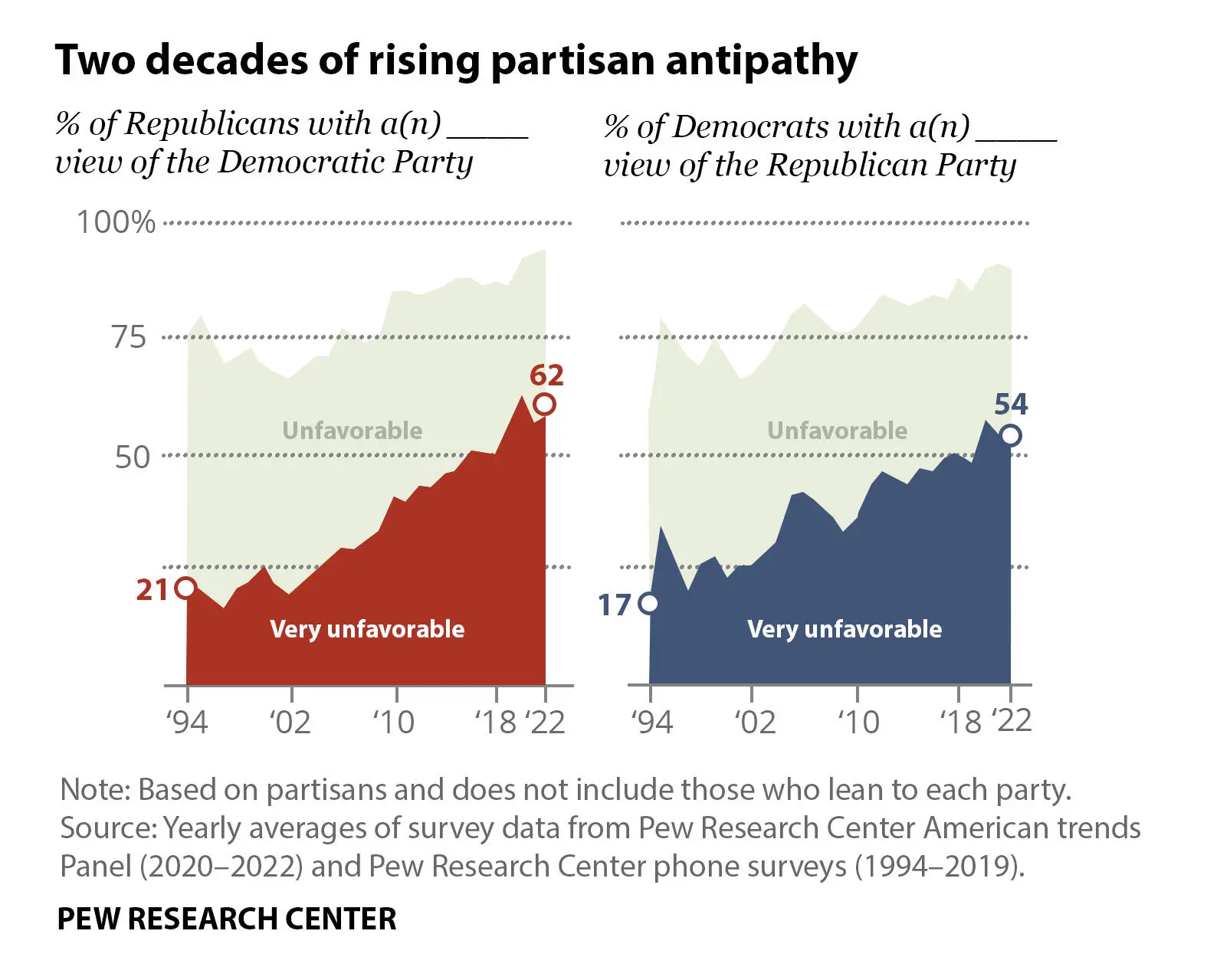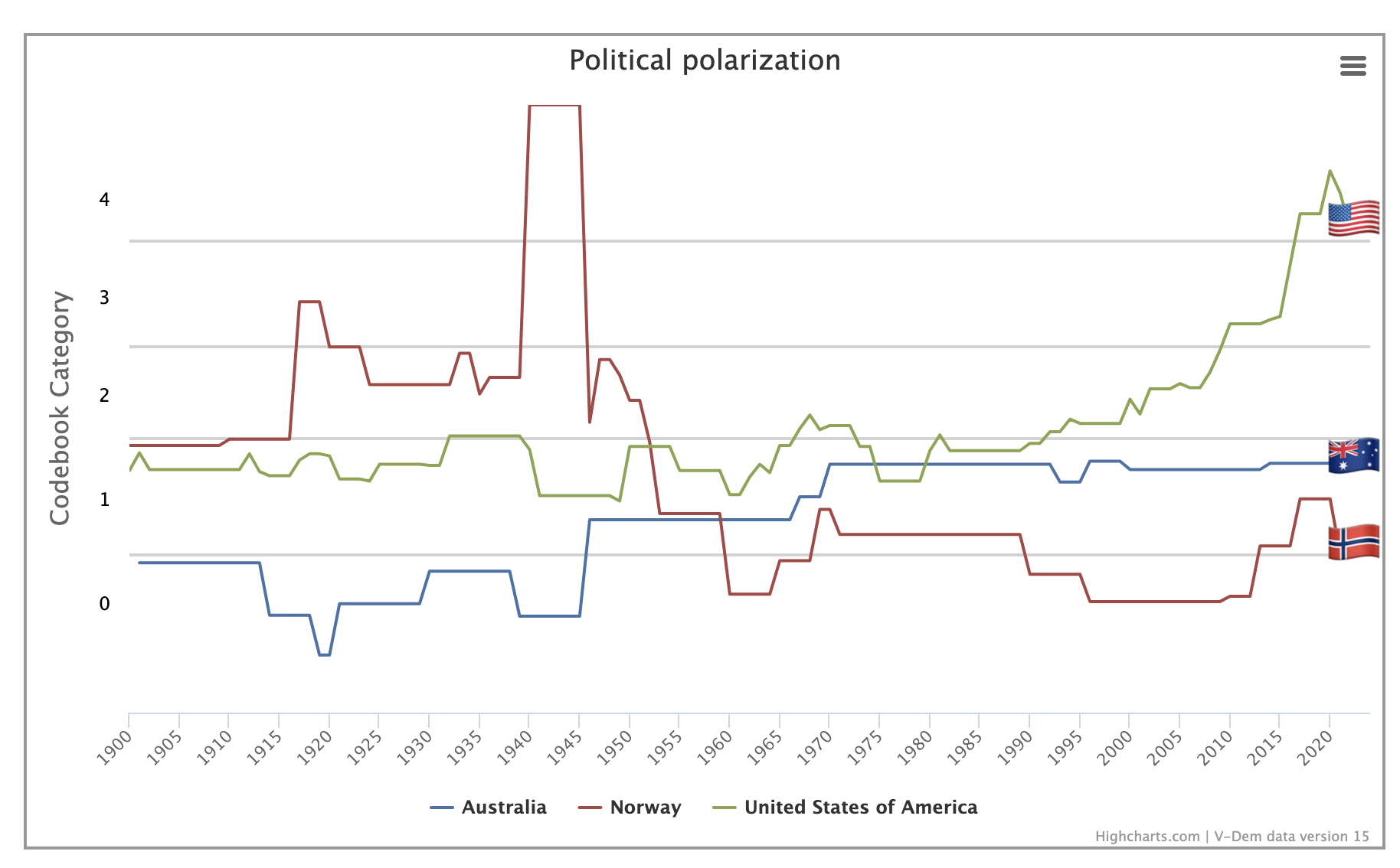This page is OUT OF DATE - it’s been rewritten as the intro spectra, where you should go.
Political polarization in the US has become a grave issue. It leads to ineffective governance, whipsawing policies, and even threatens civil war.

Reversing this trend is critical to the future of our nation, so we should try to understand its causes. Notably, this trend doesn’t show up in every Western democracy! It’s not just the internet, filter bubbles, or fake news.

The electoral mechanics of the US are part of the problem. To see why, consider a trivial example where you have a 50/50 split of red and blue voters arranged in a line according to their beliefs. With this kind of electorate, you might expect the candidates (shown as circles) to be towards the middle of that distribution as they attempt to win over the swing voters in the center.

In such an example, you’d generally see centrist candidates who have significant positions overlap. This creates less divisive polarization. This is how Australia looks in most elections.
However in America, we get something like this:

And when one candidate wins, they are so far ideologically from the voters in the losing party, it pisses them off, and contributes to negative polarization.

So why aren’t US candidates closer to the center? One reason is the way we run our primaries. Candidates are forced to be way closer to the fringes of their party. This is partially due to who votes in primaries, partially because they are closed to voters, not in the primary, and partially because donors and groups who promise finances and volunteers are further on the edges. The candidates move towards the center in the general election but can only credibly go so far.

Another reason is that candidates need to worry about third parties running in the general election. In this example, the blue candidate moves to the center to capture more voters, but they leave their flank open to a well-run green campaign and lose far blue voters to them, ultimately causing blue to lose in the general election to red.

So what can we do about it?
Solution 1: Election Reform 👷♂️
Ranked open primaries and ranked-choice voting schemes straightforwardly solve these issues. You can see my post politics-industry for a review of a book pushing for and justifying these reforms. I’m all for these, but I’m not sure how realistic this hope is.
Solution 2: Magic 🧙
Imagine you have a perfect oracle who can, before the primaries, know the result of every possible general election matchup. This oracle could then issue statements about each candidate’s chance of winning the general even before the primary is run.
Let’s consider an example.
🧙 Alice (D) has a 72% of winning the general election. Her worst matchup is Bob (R).
🧙 Bob (R) has a 68% of winning the general election. His worst matchup is Alice (D).
Hearing this, primary voters have some simple game theory.

The oracle’s predictions mean that at the primary stage, the D voters know that they will almost certainly lose if they don’t nominate Alice. The same is true for the R voters and Bob. If Alice and Bob are both nominated, instead of a blowout, it will be a close election. The very fact Alice and Bob had blowout potential means they must have been appealing to a wide swath of the electorate, so either one would be a popular moderate and thus achieve our goal of depolarizing the country a little bit.
Solution 3: Polling 🤓
The question is whether we can replace the magic oracle with advanced polling and modeling while retaining the game-theoretic effects on the primaries.
Lucky for us, these effects should occur even when our “oracle” is less than perfectly confident (or trusted). Can we get there? Here’s one sketch:
- Create a model of the demographics and psychographics of the entire electorate using a mix of public datasets and representative polling.
- Collect a schema of salient political beliefs (what should be done and why).
- Create a model of how each demographic/psychographic cluster feels about each salient political belief.
- Before each primary, create a long set of potential candidate slates (bundles of positions) that exist in this schema.
- Simulate each possible general election with generic candidates running on a permutation of slates.
- Surface a ranking of each slate’s chance to win (different for each party).
- Candidates who run in the primary would be incentivized to select a highly rated slate that they also can credibly endorse.
- Primary voters would know which candidates had “oracle” endorsed slates and furthermore have a sense of which ones credibly embody them.
It may be a long shot, but even its failure would yield substantial public good. Steps 1-3 would yield the most detailed voter preference aggregation system to date, which has the potential to unpin several other powerful ideas. If steps 4-7 only partially work, they will still align politicians closer to the people’s will.
I’m sure you already have questions and objections, but if you’re intrigued, continue on to the more detailed popularism post.
